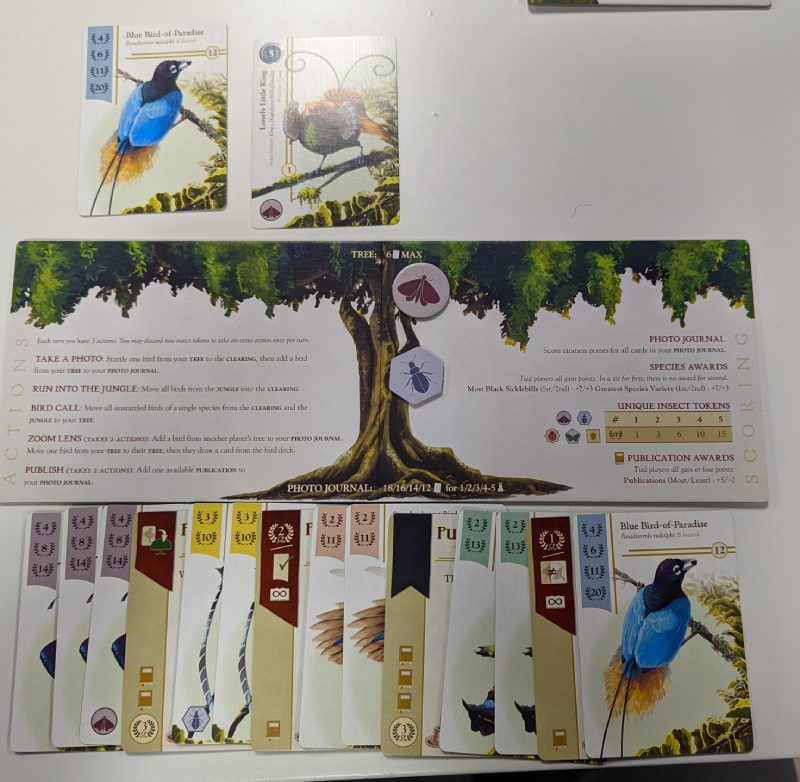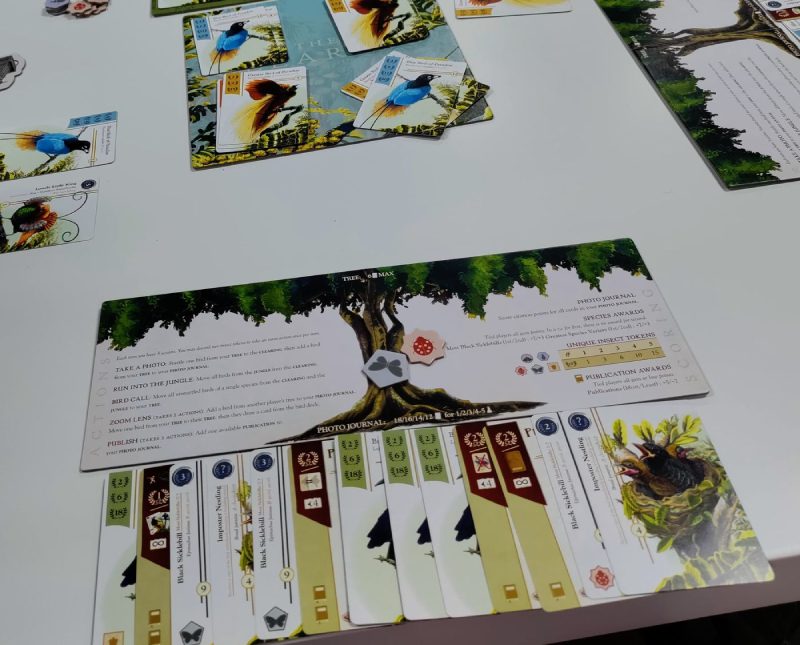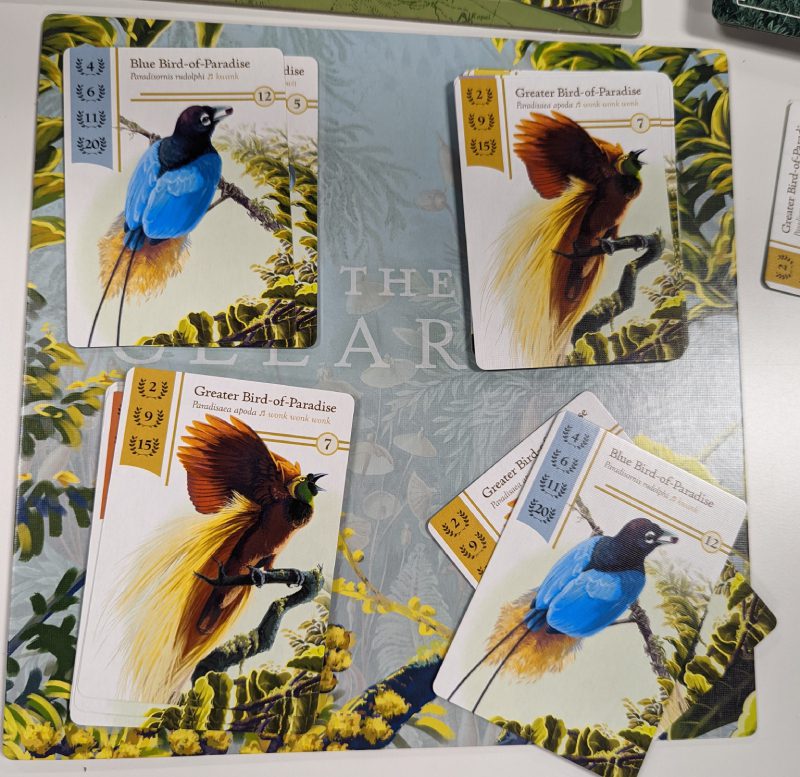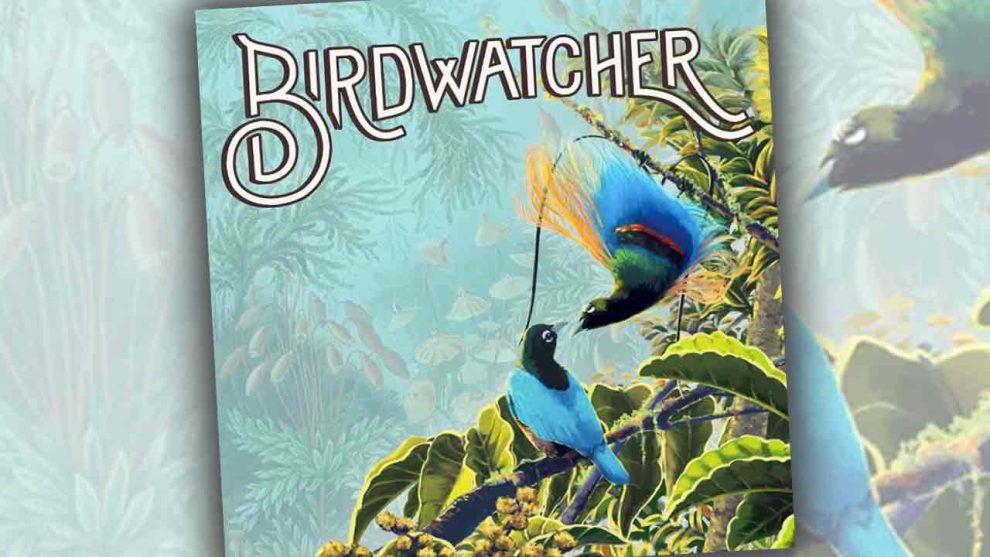Disclosure: Meeple Mountain received a free copy of this product in exchange for an honest, unbiased review. This review is not intended to be an endorsement.
One cannot deny Wingspan‘s success, regardless of how they feel about the game. Due to its popularity, a new marketable theme is injected into the veins of the industry, and publishers are taking advantage of it: birdwatching
Without Wingspan’s triumph, games like Birds of a Feather or Birdwatcher would not exist, and I wouldn’t be typing this review. A game like this couldn’t have existed ten years ago since the conventional board game concept would have involved conflict, war, or colonization.
It wasn’t the theme or aesthetics that captured my attention. Birdwatcher, at its core, is a set collection game. Set collection games get my attention as quickly as social deduction games, deckbuilders, medium rare steak, and sushi.

Vibing with the birds
As the name implies, you and your friends are avid birdwatchers. You want to take some pictures of exotic birds while writing research papers in a jungle. Since you’re a few decades behind TikTok and Instagram, you need to become famous the old-fashioned way by being the most cited bird photographer.
There is no hidden information in this card game, unlike most others. Your hand is out in the open, and there are no hidden objectives. Instead, there’s a long player board with the top portion representing the Tree and the bottom portion representing the Photojournal.
The Tree is your open hand, which you mostly use to photograph birds and add them to your Photojournal. In addition to photos, you can acquire a Publication card from the Academy and add it to your Photojournal.
The catch with the Photojournal is that after you insert a card, you cannot move it. The number of birds in a row determines your points, not how many you have. If you have two Blue Birds of Paradise together and later throw in a new bird or Publication card, this will break the set. You still get points, only not as many.
Again, all of this information is open, so everyone knows what you want, and you know what they want.
Taking a few picky wickies
During your turn, you have 3 actions to spend.
The first action you will likely do at the start of the game is to Take A Photo. Grab a bird from your tree and put it in your Photojournal. However, these cameras aren’t cell phones, so the flash from your antique cameras startles a bird. Choose another bird from your tree and place it in the Clearing.
The Clearing consists of four piles of bird cards in the center of the table. While this is the destination of startled birds, it is not the only method birds get to the Clearing. Another option to get more birds is to perform the Run To The Jungle action.
In the Jungle, there are three face-up cards. When you Run To The Jungle, you take the three cards and place them in three separate Clearing piles.
To attract birds to your Tree, do a Bird Call action. Simply choose one bird species, and all birds of that species in both the Clearing and the Jungle will flock to your Tree. Your Tree does have a strict six-card restriction, so keep that in mind.
If another player has a bird in their tree that you want, you can use the Zoom Lens action to get it. You take the bird from their tree and place it in your Photojournal. There is a high cost, as it not only requires two actions, but you must also move a bird card from your tree to theirs. They also draw one card from the bird deck and place it in their tree. They receive two birds in exchange for you snatching one.
The last action you can take is the Publish action. In the Academy, there are three face-up Publication cards, and you spend two actions to take one and add it to your Photojournal.
Publication cards are extra ways to score points. They are a mix of straight-up points, end-game bonuses, or bonus points based on the last four cards behind the Publication card.
This might seem much for a game aimed at a family audience. Fortunately, the production in Birdwatcher is not only gorgeous but also functional. The left side of the player board has a list of actions, making it simple to teach this game. Towards the right is a list of bonuses you can earn at the end of the game.
It’s those end-game bonuses where you see the game take flight.

Ending the journey
Based on everything you’ve read so far, you’re probably under the impression that this game is all about collecting the same cards in a row to get huge points while throwing a Publication card or two. While that does play a part, it is merely the beginning of this journey. When you look at the end-game benefits, you immediately understand that this is a battle on several fronts.
One of those fronts is having the most Black Sicklebills. Unlike most birds in this game, Black Sicklebills are individually scored and do not count as a set. Simple enough.
The other type of bird is the Rare Hybrids. Like the Black Sicklebills, they score on their own and have a different back on their cards, so you know they are coming. While high point single cards sound great, the real reason you want to nab them is there is yet another end-game bonus for having the most variety of birds in your Photojournal.
Bird cards sometimes feature insect icons, and after you take a photo of them, you get an insect token. They are five types of insect tokens, and at the end of the game, points are awarded based on how many unique tokens you have collected. In addition, you can spend two of these tokens on a turn to take a fourth action.
Finally, there are the book icons. Every Publication card has a book icon or several, and you want to have as many as possible. The person with the most books scores points, while the person with the fewest books loses points. Before you ask, yes, this is the Sushi Go pudding card with extra steps, and I’m completely ok with that.
Now, this would be the time where I throw in my impressions, insert a few jokes, and plant a few metaphors that only make sense in my mind. However, there is a chirping sound that has been going off since you heard about this game that we need to address it.
Is this a Wingspan rip-off?
Is it better than Wingspan?
Measuring Wingspan
Since you’ve read this far, the answer to the first question is apparent. No, this isn’t a rip-off of Wingspan. The only commonality here is cards with bird art. Since I’m going to do inevitable comparisons, I prefer Birdwatcher’s method. Wingspan feels like a guided tour of taxidermy heaven, whereas Birdwatcher showcases birds in their natural habitat.
As for the second question, the answer is obvious if you read my review of Wingspan. If you haven’t, let’s say that I am one out of the three people in the known universe that wrote a negative review on it.
My gripe with Wingspan is its design scope. It wants to shove as much as it can into a shotgun, blast it, and expect you to put it back together with your tongue.
It has hidden objectives, resource dice, engine building, resource management, action selection, set collection, end-of-round bonuses, tableau building, eggs, and a dice tower. If that sentence was painful for you to read, that’s my point.
Birdwatcher knows it’s a set-collection game and doesn’t pretend to be anything more. Not a single system or rule feels out of place. Everything here is to serve the set collection objective, and it wants to flex its muscle like it’s trying to be the Chris Bumstead of board game design.

My bird is the best bird
One area that caught my attention is acquiring cards. Every set collection or engine builder game must have a system for players to get cards, as it serves as the game’s basement to build on. It is both an obstacle and a way for players to engage with one another.
Birdwatcher’s attempt at this is fantastic. Not only is this an original idea, but it’s one that anyone can get into.
To get cards from the Jungle and Clearing, you need to do a Bird Call, and to make the best use of that call, you want as many cards of the same species in those two areas.
The challenge is the deck is random, people will toss in startled birds or Run To the Jungle to mess it up. This central area becomes the focal point of everyone’s strategies and decisions, and no one can tame it. You want the Clearing and Jungle beneficial for you, yet leave it a complete mess for your opponent, forcing them to waste precious actions to get what they need. Best of all? Understanding the situation takes seconds, not minutes, making the game’s pacing slice around the table with ease.
The competitive nature of Birdwatcher doesn’t start and end with getting cards. You will constantly examine your opponent’s Photojournals with the hunger of a private investigator, trying to decipher their intentions. Maybe they are looking for a particular bird or perhaps a Publication card in the Academy.
Despite their small presence, Publication cards are surprisingly powerful and change how you look at the birds. Some Publications cards want complete sets, partial sets, insect icons, or different birds in the last four cards. They can sometimes give you as many points as a decent set of bird cards, and there are only 18 of them in the game. When looking at my opponents’ Photojournals to determine what Publication cards they wanted, it’s not uncommon that I would have Clint Eastwood-style staredowns with them.
Making sense of it all
To me, the most surprising aspect was how well the rules link to the game’s theme. Every rule makes sense from the perspective of a birdwatcher. Taking a photo? Your flash will annoy another bird in the area and force them to flee. Doing a Bird Call for a particular species will bring them to your tree for an easy photo snap. Birds endlessly fly from one tree to another since they are birds. They are too busy trying to eat, mate, and poop on your head. Your ambitions are not their concern.
You might have noticed that I haven’t said a bad word about Birdwatcher, and that’s because it doesn’t have significant issues. It’s a game aimed at an entry-level crowd that plays in an hour, and it hits the mark with the precision of an Olympic archer.
Excluding Solo, I have played this on all player counts, and every single one works well. After playing this half a dozen times, I didn’t find any dominant strategy, suggesting the game is well-tested. As with other hour-long games like Azul, Splendor, and Century Spice Road, it has a great decision space that takes minutes to teach.
Honestly, it’s hard for me not to recommend this if you are a fan of set-collection games with a bit more entry-level flair. Beautiful artwork with easy to explain rules and engaging in interesting decisions will always lead to a game worth praising.












Add Comment